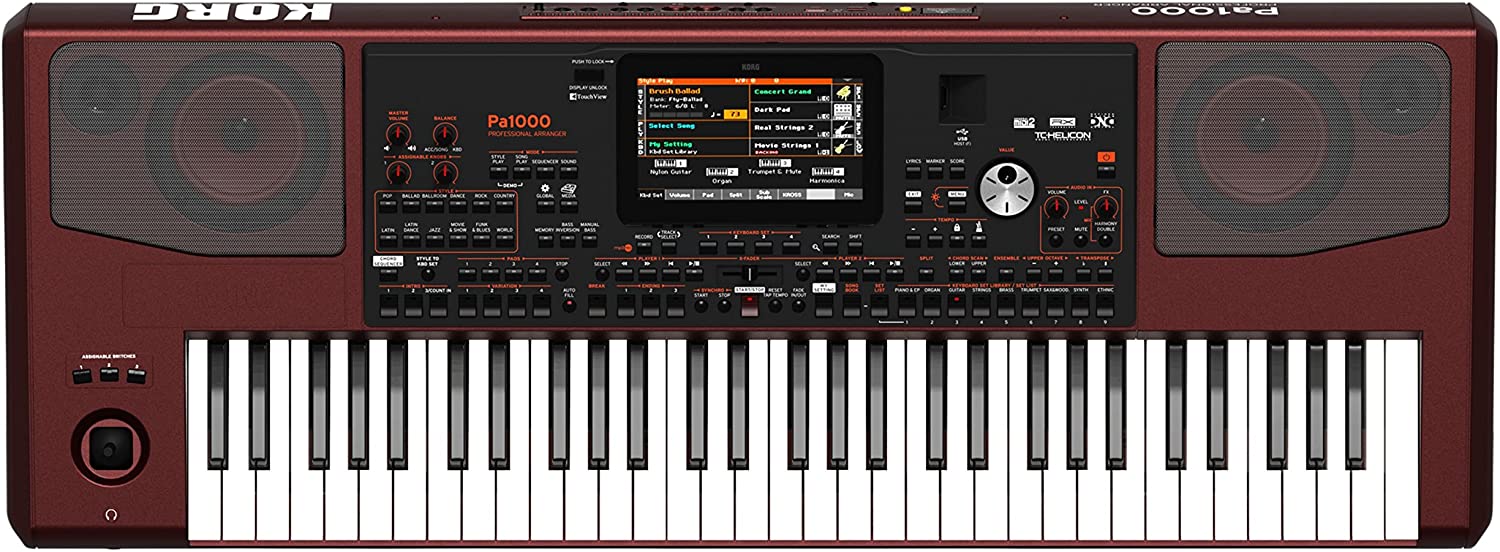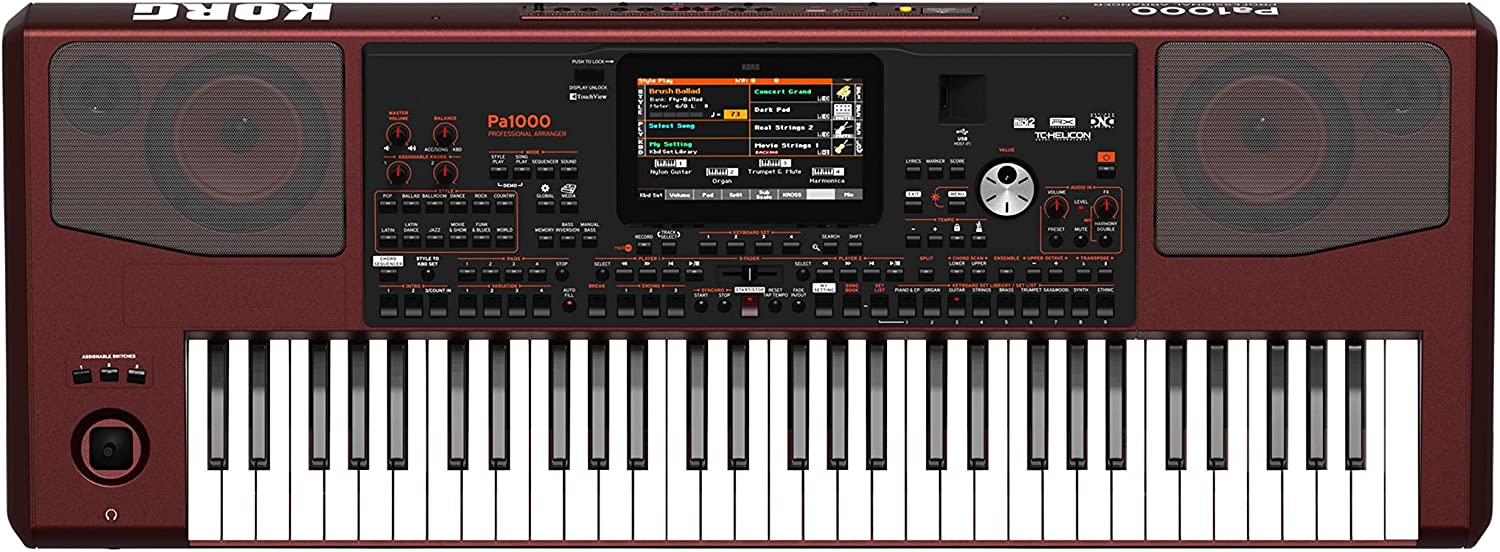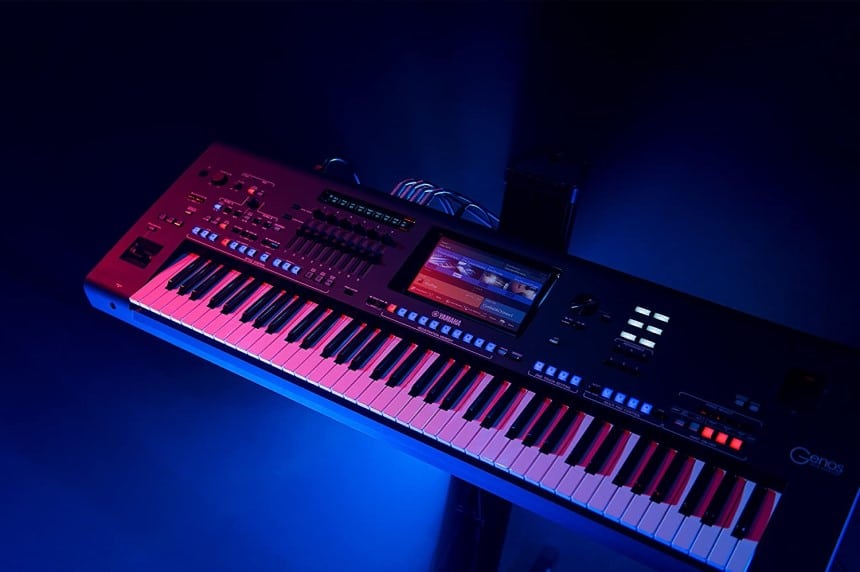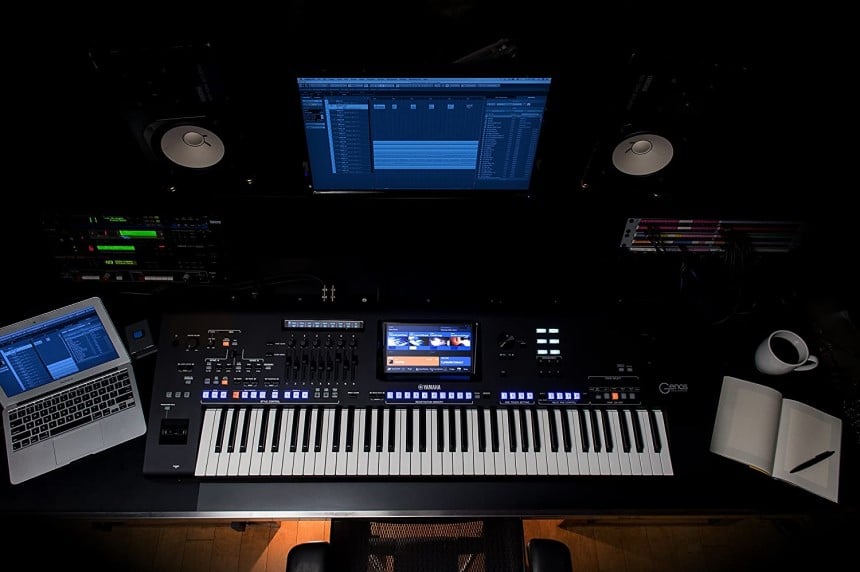
Every musician dreams of having an arrangement of audio styles in a single instrument. Imagine being able to change the tone by simply following chord changes like adding a drumbeat to get the perfect backing effect.






Multiple arranger keyboards flood the market, but not all of them are the same. We have rounded up a list of the most acclaimed units to help you make the best informed choice. The best arranger keyboard will give you great melody, structure, and chords that will allow you to have a blast. For you to get killer tunes from an arranger, you must consider a few crucial things before purchasing any unit like its sound quality, connectivity, portability, keyboard, and auto-accompaniment styles.
| № | Name | Rating | |
|---|---|---|---|
| 1 | Korg Pa300 |
9,7
|
Check price |
| 2 | Yamaha Genos |
9,5
|
Check price |
| 3 | Korg Pa1000 |
9,3
|
Check price |
| 4 | Casio CT-X700 |
9,0
|
Check price |
| 5 | Korg EK-50 |
8,9
|
Check price |
| 6 | Korg Pa700 |
8,8
|
Check price |
Other features: enhanced Rx (real experience) sound engine, 950 factory and 256 user sounds, 310 factory styles, fully programmable songbook database, 10 cm x 2 double cone speakers

The KorgPa 300 scooped the top spot for all the right reasons. The arranger is incredibly powerful and easy to use at the same time. It packs a punch with various up-to-date sounds and styles.
The arranger boasts a pristine design with 61synth keys. Any keyboardist would love the perfect feedback the keys provide. Its buttons, knobs, swatches, and joysticks combine beautifully to make music quickly.
This arranger distinguishes itself with the state-of-the-art technology; RX (Real Experience technology) which works together with the onboard amplification system to provide unparalleled realism.
What’s more, it features an internal PCM memory that can hold over 300 styles, 64 drum kits and 950 sounds. Plus, there’s a 3-band EQ for every track giving you the freedom of shaping the sounds as you like.
When it comes to accompaniment styles, the Korg Pa300 is unbeatable. It features over 310 presets and 8 to 1040 style locations.
Another praiseworthy thing about this arranger is its onboard player’s ability to read chords and lyrics from various file types including MIDI, MP3 and KAR. With this feature, your songbook will ever be full with performance-ready songs.
Further, the arranger has 4 stereo master effects processors that can power over 125 effects including delays, reverbs and chorus. It also has the popular guitar-based effects for guitar tones that are out of this world.
The arranger’s onboard has a 16-track sequencer with a quick-record function that allows you to make backing tracks quickly.
Other features: 1,652 preset voices + 58 drum/SFX kits, 550 accompaniment styles, OTS, chord looper, style section reset

This is the ultimate premium and reliable arranger keyboard. The Yamaha Genos oozes class and power with its top-notch features, and sleek, portable design. It is one of the best Yamaha arranger keyboards on the high-end spectrum.
Thanks to the Yamaha AWM stereo sampling engine, the Genos comes with a vast number of realistic voices. You get over 1600 voices, from drum kits and horns to superb grand pianos. Plus, the arranger has 9 assignable sliders that you can use to play organ sounds or control the effects’ parameters.
On top of the 1600 voices, the Genos comes with 550 accompaniment styles. Each of these styles has different variations and can be expanded on Yamaha’s expansion manager.
Genos is a complex arranger but it is impeccably easy to use. Its recording functions; the quick-recording, step-recording and multi-step recording are pretty straightforward.
What you will love the most about this arranger is how deeper its onboard effects go compared to other arranger keyboards, thanks to the VCM technology it uses. It has a whopping 59 reverbs and 30 more user settings. Its main effects include; reverbs, part EQ, master EQ and chorus among others.
When it comes to standard vocal effects, the Genos comes second to none. Its 3-band EQ, compressor and noise gate work to give your vocals an amazing performance-ready path.
Also featured is a 9-inch touch screen that will give a great playing experience.
Other features: 30 factory and 64 user presets, guitar processor, 1,750 factory sounds, 512 sounds and 256 drum kits, fully programmable music database, 2 x 100 mm woofers in bass reflex box, 2 x 25 mm dome tweeters

Korg quickly rose to be a renowned arranger keyboard brand and this is one of their recent gems. It has a couple of magnificent features that make it a powerhouse of quality sounds.
The arranger has 61 keys that are velocity-sensitive. They also have aftertouch and 128 max polyphony.
Whether you are a beginner or a professional you will certainly make the most of the over 1700 instrument voices the arranger comes with. Just like the rest of the Pa line’s range, the strings, brass, and digital pianos among other world instruments are high-quality.
Essentially, the Pa1000 features Korg’s famous DNC (Defined Nuance Control). The DNC is the real deal as it helps you control various parameters of your sound with 3 assignable buttons and a 4-way assignable joystick. You will be able to add some subtle performance nuances and breath sounds that make you sound more human.
With the 420 styles that are designed to adapt to your playing perfectly, you will sound like a real band. You’ll not only be able to play chords as you go, but also pre-enter chord progressions that the style will follow. This is a fantastic feature for a beginner or anyone trying to write a solo for certain chord changes. It works like a practice tool allowing you to test your ideas and progressions in different styles of music.
Another thing that makes this a perfect arranger for composers is the 16-track sequencer that has two ¼-inch audio inputs. This allows you to easily connect other instruments like a guitar or bass to your sequencer.
As if that’s enough, the arranger has a variety of onboard effects, including 45 guitar effects, over 150 sound effects and a TC Helicon Voice Processor.
Other features: 600 tones, 195 drum rhythms, 310 music presets, 160 songs, lesson function, MIDI recorder, smartphone shed, 4.7″ x 2 speakers

If you love to get a good pennyworth with your purchases, this should be your top consideration. The CT-X700 is one of the best arranger keyboards under 500 dollars. Just because you don’t get to hurt your wallet doesn’t mean you compromise on sound quality.
The CT-X700 offers excellent value for money with its wide array of features. It comes with 61 full-size and highly sensitive keys. With the 600 built-in tones, 100 types of arpeggio, 195 rhythms, 160 songs and 310 music presets you will always have performance-ready songs.
Plus, you can add your songs and rhythms as well as create presets, record and playback your performances. The worldwide rhythms have variations that you can edit to your liking.
Another thing you’ll like about this arranger is its sufficient audio-ins and outs. Together with USB connectivity and MIDI standard you have endless options of accessories and apps that you can use with the arranger.
Moreover, the arranger utilizes the AiX sound engine that produces fantastic instrument voices. The technology sets the arranger apart as it makes it sound like 1000bucks. It does not only enhance piano instruments, but also works to produce high-quality sounds with the strings, wind instruments, and brass.
The keyboard functions are also distinguishing features. The keyboard split function allows you to play 2 different instruments with each hand while the keyboard layer function allows you to play 2 different instruments simultaneously. The keyboard also has a plethora of features that can help a beginner learn to play the piano.
Another interesting feature is the melody suppression system. It allows you to not only play the lead role in any song but also allows you to play along with your favorites by suppressing the memory of songs played through the audio input.
Other features: Over 702 sounds, 41 drum kits, 18 demo songs, real-time recording in Style mode, 4.72″ double-cone speakers × 2

Yet another Korg. The EK50 is one of the best arranger workstation keyboards loaded with high-end features at an incredibly affordable price point.
The arranger doesn’t sound cheap at all with 702 different sounds. Each of these sounds has its own purpose. Its keys are pretty standard, but they do have the touch control feature that allows you to set their sensitivity so that they feel like weighted keys.
The arranger also has built-in speakers that allow you to play music wherever you are. This, together with the song mode are the coolest features this unit has. The song mode allows you to track a song directly into it and record your favorite performances. The recording feature comes in handy if you are learning new music genres and you want to judge your performance.
The EK50 has a very straightforward layout, thus a breeze to use. Its LCD screen is large enough and you can easily navigate it to get anything you need.
Other features: 1,700 factory sounds, 512 user sounds, 256 drum kits, Natural Ambience Drums, automatic MIDI FX generator, 2 x dual cone speakers

The Korg Pa700 is not the typical low budget arranger keyboard, but it is pretty affordable. It’s just not affordable enough for a beginner on a tight budget. Just like all the Pa series arrangers, it is an absolute superstar with myriad terrific features.
The arranger comes with 1700 factory sounds developed by the EDS-X sound engine. Plus, it utilizes the Defined Nuance Control Technology that makes instrument voices more realistic. You can also reshape rhythms, edit the drum kits and mix accompanying sounds.
The Pa 700 comes with 370 different styles that are fully customizable. Also featured are 148 effects including delays, amp simulators, reverbs, and vintage stomp box simulators. The effects also give you an impressive amount of creative control. This way you can add a retro, modern or futuristic touch to your music.
If you are a keyboardist who sings while playing, this should be your go-to arranger. You can connect dynamic mics to it and apply effects to your vocals to have the best vocal performance. With the vocal remover feature, you can easily remove vocals from an Mp3 player then sing along with the track.
Guitarists can also make the most out of this arranger. With the guitar FXs, you can add pedals and studio effects to a guitar once you have connected it to the arranger.
You couldn’t get anything better for an arrangement of audio styles in one instrument like the arranger keyboard. The flexibility of audio performances offered by an arranger keyboard is unmatched and this is what most multi-instrumentalists and musicians dream of. There are multiple brands and models of arranger keyboards on the market but not all of them are the same. This section contains information that will help you choose the best arranger keyboard for your needs.

Arranger keyboards have all types of sounds. They are made to focus more on instrument sounds like drums, horns, guitars and pianos making them as real as they can be. Rather than giving you manipulating and sound-shaping capabilities, an arranger keyboard offers a more live performance-based effect.
Arrangers are popularly dabbed the ultimate band in a box because they have arrangement features and built-in sequencers that make them more of a mobile recording studio.
Here are a few tips on how to pick the best arranger keyboard for your musical needs within your budget.
Arranger keyboards come with either 61, 73, 76 or 88 keys. The 61-key model is the best a first-time electric keyboard player can choose. This is because they have un-weighted keys and that means you wouldn’t have to use so much pressure on the keys when playing. On the flip side, weighted keys equate to playing quality, therefore it is a tradeoff. If you don’t feel ready to invest in a 61-key model, you can choose one that has less keys, but you will suffer the consequences of its limitations as soon as you learn playing.
If you are a seasoned piano player, consider choosing the 73-, 76-, or 88- key arranger. The 88-key models are pretty costly but the best electronic alternative to a real piano.
Another important thing to consider is touch sensitivity especially if you’d like to add subtlety as you play. Be sure to go for an arranger that has touch sensitivity which you can turn off when you don’t need it. Korg Pa300 is a prime example.
This is a crucial function that you should give top consideration when choosing an arranger keyboard. Its operation is pretty basic, it allows you to play some notes on the lower range of your keyboard then instructs the system to start playing some backing music. In result, you get the sound of a full-band playing a professional backing track that you have total control over.
Accompaniment uses rhythms or styles that have been played and recorded by skilled musicians to produce the sound of a backing band. Be sure to pick an arranger keyboard that comes with full auto-accompaniment.
Sound quality is the main determinant of an instrument’s effectiveness when it comes to performance. You should consider the bit depth and sample rate of an arranger before buying one. To get high-quality sounds that will inspire you, choose an arranger with sounds recorded from premium acoustic instruments.
Another thing you want to consider when looking at the sound quality is the voice options offered by the arranger. The main reason why most musicians buy an arranger keyboard is to access all the multiple voice options it offers. Choose one that has tons of voice options for maximum versatility and customizability. The more the voice options an arranger keyboard features the more costly it is, therefore, as a beginner you can go for one with less.
Polyphony is the number of sounds an arranger keyboard can produce at a go. If you want an arranger that can mimic a real band or orchestra then choose one with extensive polyphonic capabilities.
The amount of controls you should consider largely depends on what you will be using the arranger for. Go for one that comes with a visual display that has a touch capability for ease of use. It will give you complete control over the functions of your arranger keyboard. Other controls would be like knobs and slider.
If you are a beginner, you don’t want an arranger with so many controls as they would confuse you. You would have to keep checking the manual before you wrap your head around all of them.

USB and MIDI are the most common connectivity options for various keyboards. The most recent models have incorporated iOS capabilities to give you unlimited access to a plethora of performance, recording and practice apps using you smartphone or tablet. You also get to enjoy cloud-based storage and musical collaborations.
Musical Instrument Digital Interface (MIDI) is a communication protocol. MIDI messages usually contain no sounds, thus serve as a blueprint that hints at a hardware or software like DAW the notes to play at a given velocity. A good example of a MIDI message is when a passage is sent to a keyboard to be played in the exact same way without any of the sounds available in the keyboard.
You must consider if your arranger keyboard has MIDI compatibility for it to be able to send and receive MIDI messages.
The size and weight of an arranger are the main determinants of its portability. Most units are lightweight and compact thus can be easily carried from one gig to another, while some models tend to be heavier. If you are an on-the-go performer this should be an issue. You should aim for the lightweight and compact models that offer all the features you need to play music like the Korg EK-50.
Not all models have built-in speakers. Speakers allow you to play or perform just about anywhere. Some units like Casio CT-X700 have the standard double-cone speakers that produce a reasonable sound quality. Others like the premium Korg Pa1000 go out of their way to include 2x1000mm woofers.

Consider buying an arranger that offers multiple styles like the Korg Pa1000, whether you are a beginner of seasoned player.
This is an important feature to consider, especially if you are learning to perform new music genres. You can record yourself and judge how good or bad you and whether you need to make any changes.
A synthesizer, on the other hand, is an electric keyboard that can generate a wide range of sounds. Synthesizers are also smaller and portable.
The main difference between an arranger keyboard and a synthesizer is that an arranger is designed for solo performances while a synth is designed to be played with other musicians.
The magic behind arranger keyboards is every musician’s dream. They make you feel like a superstar when doing a solo performance. There are so many of them out there, but not all are within reach budget-wise and not all of them are good. It can be daunting to pick one from that suits your needs especially if you don’t know much about them. Well, not after reading through this guide. There are hints and pointers on how to get the best arrangers with detailed reviews on the best-rated models.
Topping our list, the Korg Pa300 is one of the best 61-key arrangers that money can buy. It is reach with features that high end models have yet you don’t have to sell a kidney for it. Our premium choice, the Yamaha Genos is undoubtedly the best Yamaha arranger keyboard out there. Almost every professional swears by it. It offers unlimited options when it comes to voices and styles which come with a hefty price tag.
Our third pick, the Korg Pa1000 is the best professional arranger keyboard any composer can get their hands on. It was built with composers in mind. Its sounds are incredibly expressive and realistic. However, it’s a bit on the pricey end, thus not a good beginner option.